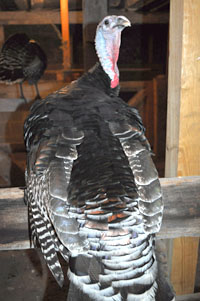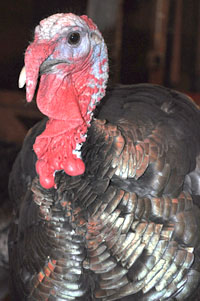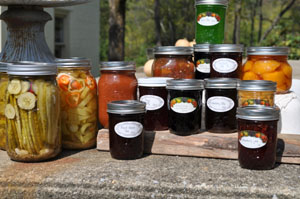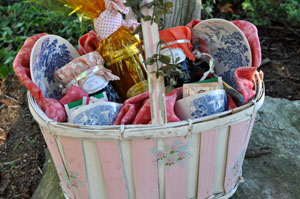
Relaxed Tom
When we began to raise turkeys a few years ago, I had no idea about the “show” they were capable of: the delicate dances, intricate and varietal sounds and calls, and the careful choreography of their mating rituals. Silence does not appear to be in their vocabulary. At any given point during the daylight hours, you can hear the hens and their sharp clucks and the toms gobbling virtually in unison.
Feeding time always brings excitement in the barnyard and the turkeys are no exception—their appearance changes almost instantly!
Unbelievably, the snood (according to the Wild Turkey Federation), which is perched atop the beak, has no known function. It will redden and engorge when the tom is excited and shrink to less than an inch and return to a shade of blue when the tom is relaxed.

Engorged snood, caruncles and dewlap

Excited over feeding time
The “caruncles” are bulbous appendages which appear on the neck and head and the dewlap is the skin which connects the underside of the beak to the neck (both sexes). On toms, both of these areas redden and the caruncles will enlarge when strutting or acting aggressively.
Toms possess a somewhat modified feather called a “beard” which protrudes from the center of the breast. It grows three to five inches a year.
As you can imagine, the toms will put on quite the display with their shades of red and magnificent plumage. Do you know when it came time to make the Big Bird costume on TV’s Sesame Street, they reached for white turkey feathers and died them yellow?
The turkey: a natural showstopper!

 Baw Blue, our devilishly handsome Navajo-Churro ram will return to his home farm in a few days. We heeded his owner’s warning and gave him full and free access to the girls. (Translation: we did not venture into the pasture while he was here except for feeding and watering. Blue’s known to be quite territorial when it comes to his “girlfriends.”)
Baw Blue, our devilishly handsome Navajo-Churro ram will return to his home farm in a few days. We heeded his owner’s warning and gave him full and free access to the girls. (Translation: we did not venture into the pasture while he was here except for feeding and watering. Blue’s known to be quite territorial when it comes to his “girlfriends.”)




 Rebecca Gunther, of
Rebecca Gunther, of 

 I was bound and determined NOT to let Oneida show ME up in the ring (after all, Ingrid was there!) so I kept her at my side with no slack in the lead and a hand firmly on the back of her neck and another cupping her jaw. Imagine my dismay, after Ingrid’s first few passes, when she asked me to move to one end of the line with Oneida. I had watched a few judgings before this and knew that the end where she was moving me was not where the winners had been repositioned. I probably had “rookie” stamped on my forehead! As beautiful and deserving as Oneida was, I was convinced I had done something as a handler to disqualify us. I was pretty sad.
I was bound and determined NOT to let Oneida show ME up in the ring (after all, Ingrid was there!) so I kept her at my side with no slack in the lead and a hand firmly on the back of her neck and another cupping her jaw. Imagine my dismay, after Ingrid’s first few passes, when she asked me to move to one end of the line with Oneida. I had watched a few judgings before this and knew that the end where she was moving me was not where the winners had been repositioned. I probably had “rookie” stamped on my forehead! As beautiful and deserving as Oneida was, I was convinced I had done something as a handler to disqualify us. I was pretty sad.
 Not only was this rookie wrong about the line-up, Oneida captured a blue-ribbon for her class and we went on to grab the Grand Reserve ribbon!! I couldn’t believe it! Well, it wasn’t “we” after all. Oneida is a one-of-a-kind Navajo-Churro and Ingrid validated that. However, I’d like to think my grip on that little girl that day ushered our chances right along in the ring.
Not only was this rookie wrong about the line-up, Oneida captured a blue-ribbon for her class and we went on to grab the Grand Reserve ribbon!! I couldn’t believe it! Well, it wasn’t “we” after all. Oneida is a one-of-a-kind Navajo-Churro and Ingrid validated that. However, I’d like to think my grip on that little girl that day ushered our chances right along in the ring.



